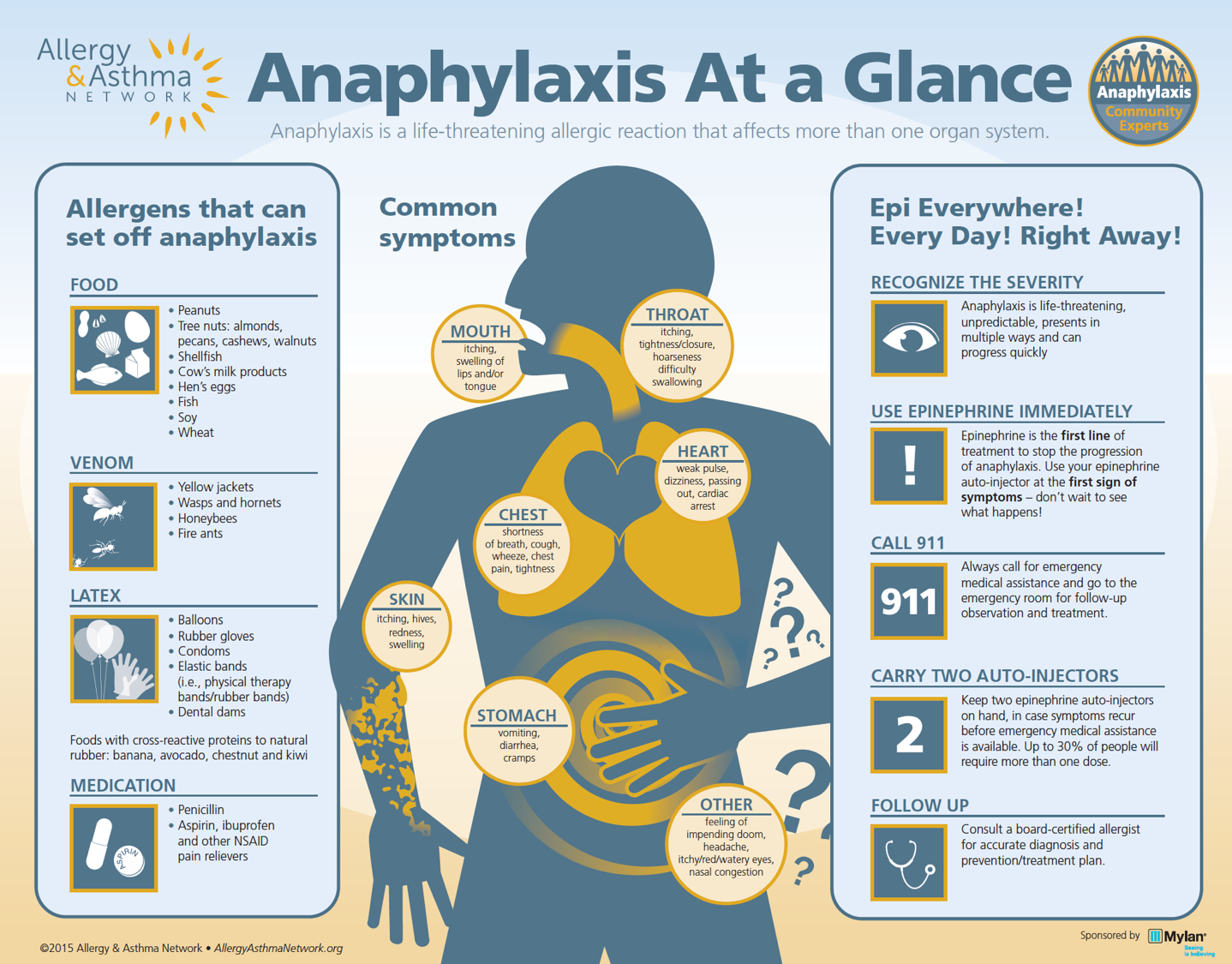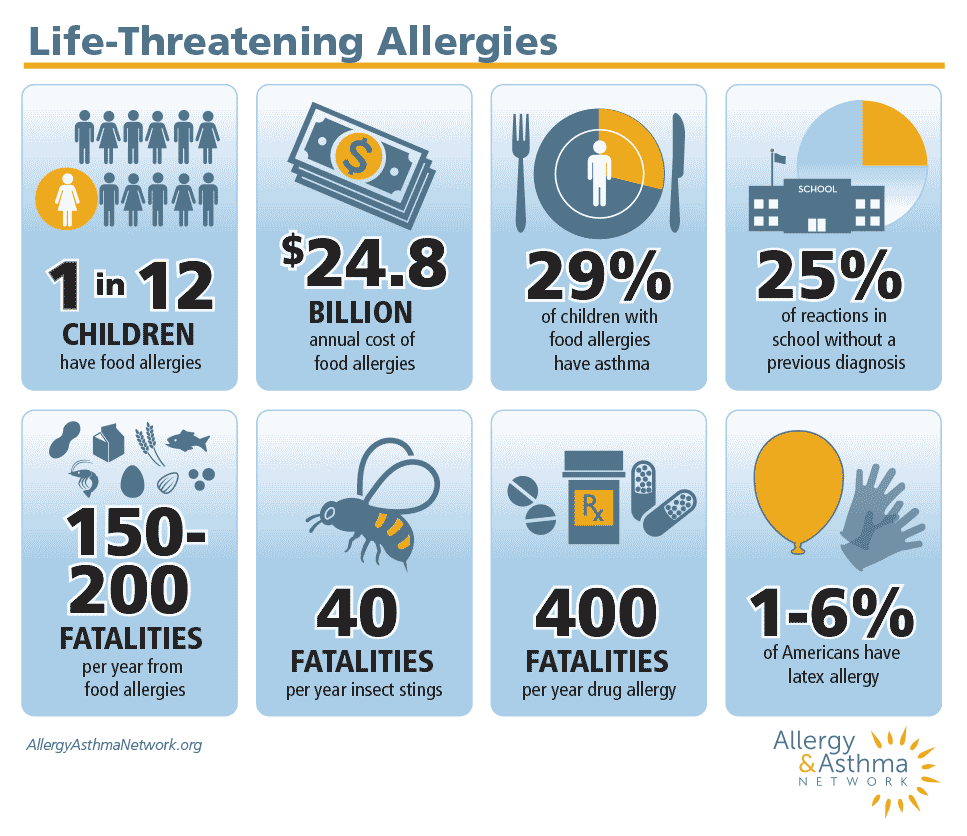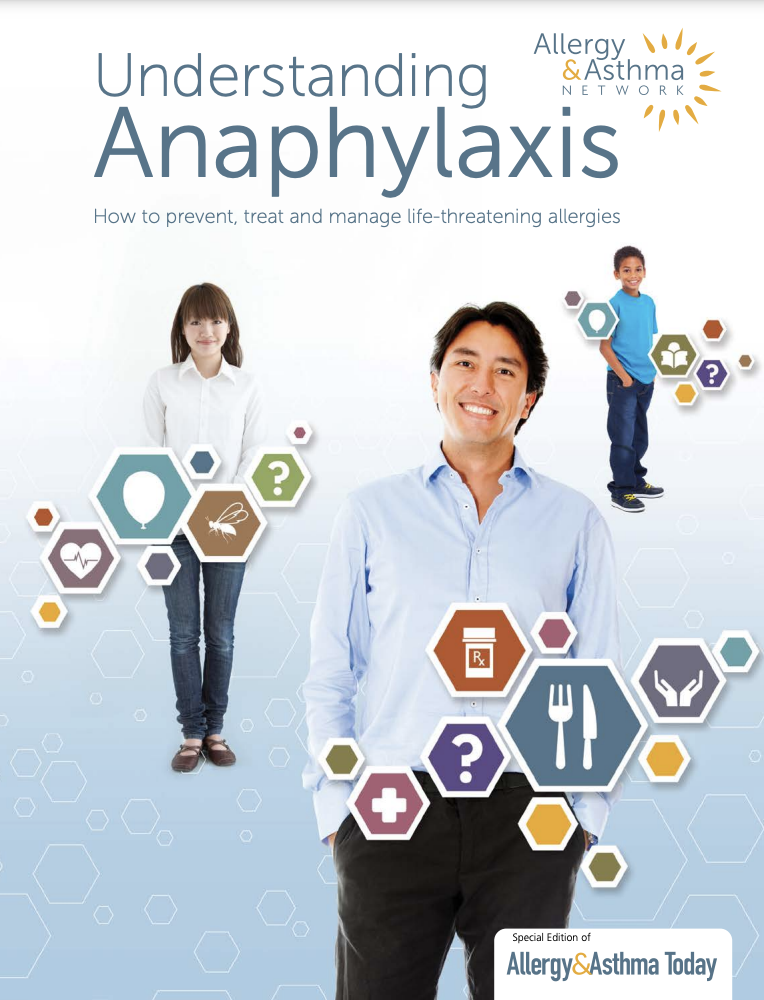What is anaphylaxis caused by?
Anaphylaxis is usually caused by a reaction one of the following:
- food
- insect venom
- medication
- latex
- vaccines (in rare cases), including anaphylaxis to COVID-19 vaccines
Anyone at risk for anaphylaxis can have a life-threatening allergic reaction – even if previous reactions were mild.
NOTE: Severe reactions can start out with mild symptoms and quickly get worse. Deaths from anaphylaxis have occurred 30 minutes after eating a food allergen and 15 after being stung by a bee.

What are signs and symptoms of anaphylaxis?
Symptoms can be different each time a person experiences anaphylaxis and may vary in severity each time. Once symptoms start, they usually progress quickly.
Symptoms typically involve more than one organ system of the body and can include:
- Skin: itching, redness, swelling, hives
- Mouth: itching, swelling of lips, tongue
- Stomach: vomiting, diarrhea, cramps
- Respiratory: shortness of breath, wheezing, coughing, chest pain and/or tightness
- Heart: weak pulse, dizziness, faintness
- Headache, nasal congestion, watery eyes, sweating
- Confusion, feeling of impending doom
- Loss of consciousness
While skin symptoms, such as an itchy rash or hives, are common with anaphylaxis, they do not always occur. Ten to 20% of the time, anaphylaxis will occur with no skin symptoms.
What is anaphylactic shock?
Anaphylaxis and anaphylactic shock are terms that are usually used for the same thing. A drop in blood pressure and narrowing of the airways in response to the exposure to an allergen can officially be called anaphylactic shock, while most people refer to it as anaphylaxis. It is treated with epinephrine first, epinephrine fast.
How common is anaphylaxis?
Research shows that it occurs in about 1 in 50 people and some believe the rate is even higher.

What is the treatment for anaphylaxis?
The first line treatment for anaphylaxis is epinephrine. It’s the ONLY medication proven to stop a life-threatening allergic reaction. Epinephrine needs to be given as soon as anaphylaxis symptoms occur.
Any delay in administering epinephrine greatly increases the chance of hospitalization. Delaying or failing to use epinephrine has been associated with fatalities.
Can antihistamines like Benadryl® help with anaphylaxis?
Antihistamines will not reverse anaphylaxis. Doctors recommend using an epinephrine auto-injector as the first treatment at the sign of any severe allergic reaction. Epinephrine will not harm a patient.
Antihistamines only treat a few minor symptoms of anaphylaxis – like hives. Antihistamines take about 30 or more minutes to take effect, which is far too long to treat an urgent medical condition.
Don’t wait. Don’t delay giving epinephrine. One more time: epinephrine will treat a life-threatening allergic reaction – antihistamines will not.
What is a biphasic reaction?
After some people experience an anaphylactic reaction, they will have a secondary, or biphasic reaction. After someone appears to recover from an anaphylactic reaction, a second reaction can occur (without any additional exposure to an allergen) up to 12 hours later or longer. While symptoms are often milder than the initial reaction, they often require a second dose of epinephrine.
It’s important not to leave someone alone following an allergic reaction. This is the main reason why you need to go to the emergency room after using epinephrine.
What to do if you are at risk for anaphylaxis?
People at risk for anaphylaxis should carry two epinephrine auto-injectors at all times. The epinephrine auto-injector needs to be used at the first sign of symptoms and seek follow-up medical care right away. Thirty-percent of people need a second dose of epinephrine to relieve their symptoms.

Studies show that many parents are hesitant to give their child epinephrine. They are often fearful of hurting their child (or themselves) as the primary reason. Sometimes they are uncertain if their child is having a dangerous allergic reaction. Parents need to remember that epinephrine is the life-saving treatment for an allergic reaction and must be given without delay.
What is an Allergy and Anaphylaxis Emergency Plan?
A helpful tool when it comes to managing and treating anaphylaxis, especially in children, is an Allergy and Anaphylaxis Emergency Plan. This is a plan that includes information about a child’s allergy, asthma, and provides an outline of symptoms to watch for and how to give epinephrine. It is an important tool for families, grandparents, caregivers and school staff. Parents should ask their doctor for a completed plan.
How do you use an epinephrine injector?
Epinephrine injectors contain a premeasured dose of epinephrine. Two different strengths are available for treating different body weights.
There are several different brands of epinephrine injectors available. Each has its own operating instructions. Be sure to visit the website of the device you are using so you can view the training video and learn how to operate the specific device you have.
Some epinephrine treatments are available as an auto-injector while some are a pre-filled syringe. Be sure you know what your prescribed device is.
© 2021 Allergy and Asthma Network

Last updated : 12/11/2020